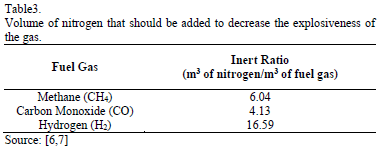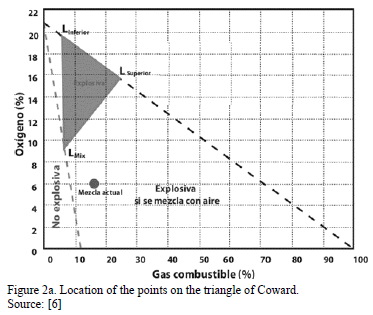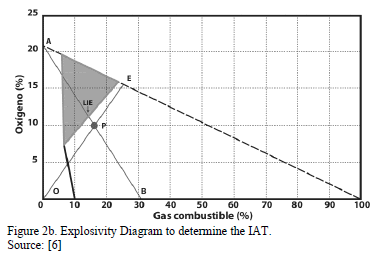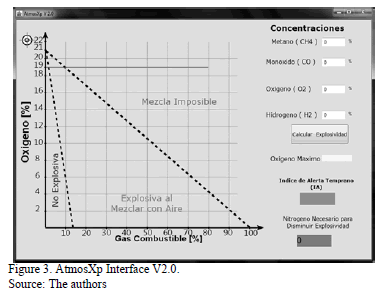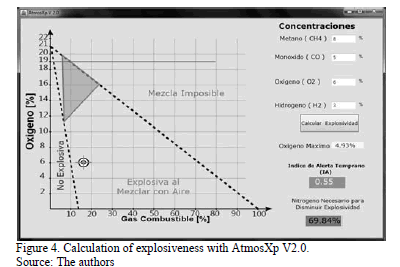Serviços Personalizados
Journal
Artigo
Indicadores
-
 Citado por SciELO
Citado por SciELO -
 Acessos
Acessos
Links relacionados
-
 Citado por Google
Citado por Google -
 Similares em
SciELO
Similares em
SciELO -
 Similares em Google
Similares em Google
Compartilhar
DYNA
versão impressa ISSN 0012-7353
Dyna rev.fac.nac.minas vol.81 no.187 Medellín set-/out. 2014
https://doi.org/10.15446/dyna.v81n186.40520
http://dx.doi.org/10.15446/dyna.v81n187.40520
Detection of explosive atmospheres using the software AtmosXp V2.0
Detección de atmosferas explosivas usando el software AtmosXp V2.0
Carlos Mauricio Álvarez-Álvarez a, Angélica María Zapata-Montoya b, Sandra Marcela Montoya-Cañola c, Oswaldo Ordoñez-Carmona d & German Darío Zapata-Madrigal e
a Facultad de Minas, Universidad Nacional de Colombia, Colombia. camalvarezal@unal.edu.co
b Facultad de Minas, Universidad Nacional de Colombia, Colombia. amzapatamo@unal.edu.co
c Facultad de Minas, Universidad Nacional de Colombia, Colombia. smmontoyac@unal.edu.co
d Facultad de Minas, Universidad Nacional de Colombia, Colombia. oswaldo.geologo@gmail.com
e Facultad de Minas, Universidad Nacional de Colombia, Colombia. gdzapata@unal.edu.co
Received: October 28th, 2013. Received in revised form: March 10th, 2014. Accepted: July 22th, 2014.
Abstract
The conditions of explosive atmospheres and accumulation of gases within underground coal mines require a detailed analysis and the development of models and mechanisms that allow their detection. For this purpose we have developed the software AtmosXp V2.0 which includes the diagram of Coward for the analysis of these explosive mixtures.
Keywords: Atmospheres, Underground Mining, Coward's diagram, Coal, Explosive
Resumen
Las condiciones de atmósferas explosivas y acumulación de gases dentro de las minas subterráneas de carbón requieren un análisis detallado y el desarrollo de modelos y mecanismos que permitan su detección. Para tal fin se ha desarrollado el software AtmosXp V2.0 que incluye el diagrama de Coward para el análisis de estas mezclas explosivas.
Palabras clave: Atmósferas, Minería Subterránea, diagrama de Coward, Carbón, Explosividad.
1. Introduction
Within the most important hazards to which persons dedicated to the work of underground mining of coal are exposed, it highlights the exposure to high concentrations of gases, oxygen deficiency, explosive atmospheres and landslides that occurred inside the mines. In spite of the efforts made by companies, government and individuals responsible for the safety and hygiene in mining, there are not practical mechanisms that can effectively minimize these dangers.
Colombia has a record of 51 accidents submitted between 2005 and July 31 of 2011 which were caused by explosions and toxic and explosive gases accumulation such as methane (CH4) like the one that occurred on February 1, 2011 at the Escondida mine, located on the sidewalk Penalties of Boquerón, municipality of Sutatausa (Cundinamarca), where there was an explosion of methane accumulation and that left a balance of five deceased persons[1], also on 16 June 2010 in the San Joaquin mine, located in the municipality of fakes (Antioquia), where 73 miners were killed by an explosion caused by the accumulation of methane gas [2]. The country also has a record of 61 accidents caused by oxygen's deficiency (O2) within underground coal mines [3].
The active regulations in Colombia for the hygiene and safety in mining, set out in the decree 1335 of 1987 [4] the minimum conditions of concentrations to toxic gases and explosives, (Table 1), but many of underground coal mines do not count with devices or methods for determining these conditions.
Within underground coal mines are conditions of temperature, concentrations of gases and use of machinery that facilitates the generation and production of fires and explosions. To minimize and prevent this tragic events inside the mines have been implemented mechanisms, which in a nutshell, minimize the factors of explosion, as the case of the use of inerting gases and efficient ventilation systems designs. In many cases, these mechanisms are not sufficient, since in practice the conditions, concentrations of gases and explosive mixtures are very changeable.
2. Explosive mixtures
The interior of the coal mines generates large quantities of gases with different chemical properties and behaviors, so it is necessary to make a classification of them as asphyxiating gases, toxic gases and flammable gases. For the generation of explosions and fires, the toxic and flammable gases There have the utmost importance. Flammable gases: Methane and Hydrogen. Toxic gases: Carbon monoxide and hydrogen sulphide.
The combination of these gases at the underground environment of the coal mines can generate explosive atmospheres, rather than relying on the percentages of participation and concentration of each gas, they can be explosive when mixed with air or non-explosive [5]. The conditions and explosive concentration's limits for the gases that can be found in the environment of the coal mines are shown in Table 2
Within the requirements of the Colombian legislation in force, in particular the Decree 1335 of 1987, the conditions for concentrations of toxic gases and explosives are dealt with separately and individually. But in practice due to the behavior and gassing-dynamic, mixtures are impossible to avoid and control, so the strategy is to design and implement a model or mechanism that allows the detection of these explosive mixtures to the interior of the coal mines.
3. Coward's triangle
Within the methods that exists for the detection and characterization of explosive atmospheres the method of the diagrams or triangles of Coward stands out as one effective and simply way of illustrate the gases mixture behaviour. It was published by Coward and Jones in 1952 and is considered as a fast and easy way to determine the explosiveness of a mixture of gas [6]. The method involves those gases that can cause a deflagration or an explosion, as the toxic and flammable gases.
The diagram of explosiveness only involves three combustible gases, which are the methane (CH4), hydrogen (H2) and carbon monoxide (CO) and two inert gases covered by the excess of nitrogen (N2) and carbon dioxide (CO2). In accordance with the proportions of all these, an atmosphere can be explosive or not [5, 6]. For each fuel gas, individually, it is possible to construct a triangle defined by three explosive points as shown in Fig.1.
There are studies and modifications concerning the use of Coward's Triangles like the ones presented in [8]. Such modifications consider the mixture interaction with some other gases in order to enhace the explosivity risk calculation of the mixture. This interaction requires a recalibration of the Coward's method presented in this work, wich is why it would be complex to integrate the algorithm with some other platforms.
To determine the condition and state of the mixture of gases, and be able to determine the explosiveness or not of the same, it is necessary to carry out the following calculations:
3.1. Determine the percentage of total fuel gases
If the CH4, CO and H2 have a concentration (in percentage) of P1, P2 and P3, respectively, and they do not react chemically between each other. The total concentration of combustible gases (PT) is calculated as the sum of the concentration of each:

3.2. Calculate the limit of explosiveness to the mixture of gases
By means of the Chatelier's principle, the boundary of explosiveness of the mixture of combustible gases CH4, CO and H2 is obtained using the equation 2. Where L1, L2, L3 correspond to the limits of stoichiometric value determined in Table 2 for each of the gases, methane, carbon monoxide and hydrogen.

The same equation 2 is used to determine the value of the upper and lower limits, only by changing for the upper or lower limit for each particular gas given in Table 3, the values of L1, L2, L3.

3.3. Determine the concentration of nitrogen required by mixing to decrease its explosiveness
This value lets you know the amount of nitrogen that should be added to the mixture of gases for which these become not explosive. It is also used to determine the minimum content of oxygen from which a mixture begins to be explosive and that is calculated using equation 6.

Where Lmix is the percentage of fuel mix (calculated from the equation 2), PT is the total concentration of fuel ( %) and N+ is the volume of excess nitrogen must be added to argon the explosive gases (also called the Radio Inert). The values of nitrogen required for stabilizing the gases presented above can be seen in Table 3.
3.4. Determine the minimum oxygen content from which the mixture becomes explosive
The minimum content of oxygen (in percentage) is regularly the amount of oxygen content in the atmosphere, which, in surface depends on the height. In an underground mine this value depends on the ventilation [5, 7] and it is estimated as follows:

The Coward's diagram is useful in the follow-up to the gas mixtures, although this requires plotting the analysis of each of the samples, because every time the corresponding triangle changes shape and position, the same as the point that represents the mixture [5]
The location of the point of mixing within the Coward's diagram is done by mapping the position with the coordinates obtained using the values of total concentration of combustible gases and the total concentration of oxygen in the mixture.
Due to the method of Coward only indicates whether a given mixture of gases is explosive or not, it is necessary to implement an early-warning Index (IAT), to monitor the movement of the point of mixing and provide an early warning in case of possible explosiveness.
Fig.2 shows a point for mixing implicated P, this point will move through the line AB dilution as fresh air is mixed in the atmosphere underground, on the other hand, if what is mixture is more content of combustible gases the point P will move through the line OE, for both cases, zooms in or out of the area of explosiveness; With this basis the IAT will be determined by the ratio of distances between the y-axis to the point of mixing (PB), measured in the AB line and the distance of the X-axis until the lower explosive limit (LIE).

4. Design and implementation of AtmosXp V2.0
Knowing the great need to perform an analysis of the conditions and state of the atmospheres within underground coal mines, in this work, it has been designed the software AtmosXp V2.0 as a rapid and comprehensive solution that involves the method of Coward as a basis for its operation. The design of the software AtmosXp V2.0 is done in compliance with the requirements of speed and efficiency which are required to have a system for real-time monitoring, and that can be integrated to obtain faster decision-making and control actions determination, when an alarm or status of an explosive atmosphere.
AtmosXp V2.0 was designed with Visual Studio and Microsoft Expression Blend 3, allowing them to develop a user-friendly interface and easy to understand for the user. In the Fig.3 shows a view of the main panel of AtmosXp V2.0.
The presented software , accounts with several details that improve their performance in comparison with other software, this is the case of the use of a detailed scale for the oxygen concentrations and highlights the value of 19% oxygen concentration that must be met by legislation [4]. It is important in practice, to know all the values mentioned above as are the IAT, the maximum oxygen from which the mixture becomes explosive, and the nitrogen needed to decrease its explosion by enabling you to take decisions and actions of control to prevent tragedies.
For the efficient use of the software must have data for the concentrations of the gases involved in the method of Coward. To make a brief introduction fees an illustrative example to show the operation of the software and the manner of operation of the same.
5. Case study with AtmosXp V2.0
5.1. Atmosphere Explosive when mixed with air
Knowing the values of concentrations of gases, you get a mixture of gases with a content of 8% of CH4, 3% of H2, 5% CO, 6% O2, item is to enter them into the appropriate box for each one in the AtmosXP V2.0 software and select the option Calculate Explosiveness, are shown in Fig.4 in AtmosXP V2.0 data obtained.
The point of mixing is determined by the pointer which has the shape of two circles of color black and that contains two lines in the form of red cross. In more detail we can then observe the minimum level of oxygen content from which the mixture becomes explosive 4.93 %, the IAT is 0.55 and the value for the concentration of nitrogen required to decrease the explosiveness is 69.84 %. Within the analysis of explosive atmospheres when mixed with air the value of the IAT throws an important value that helps to determine the proximity and possibility that the atmosphere becomes highly explosive.
The red area represents the triangle formed by the limits of mixture, upper limit and lower limit which is calculated using equation 2 and which, in the case of the lower limit and upper limit is determined by placing on the shaft of Fuel Gas [%] the value obtained with equation 2 and intercepting with the dotted line as shown in Fig.2.
5.2. Highly explosive atmosphere
Due to the use that is expected to be the software AtmosXp V2.0 it account with warning signs and pop-up windows when conditions can arise from a highly explosive atmosphere, the values of concentrations that could generate this condition are [8] 5.68 % of CH4, 0.3% of H2, 3.25% of CO, 13.9% O2, as shown in Fig.5.
When you have the condition of a highly explosive atmosphere, AtmosXp V2.0 issues an alert and delivery the values of nitrogen needed to decrease the explosiveness and the minimum oxygen. For this case the value of minimum oxygen allowed in order to make the mixture explosive has a value of -10.67% as can be seen in Fig.5, in the section of Maximum Oxygen, indicating that it is required to remove oxygen from the atmosphere or add nitrogen.
6. Conclusions
The preventive measures taken in accordance with the current Colombian legislation does not include the analysis of mixtures and conditions of explosive atmospheres.
It is important to have detection systems within the coal mines because they facilitate the decision-making and helps to prevent tragedies. With the help of AtmosXp V2.0 you can get immediate results of the explosiveness of the underground mining environment.
AtmosXp V2.0 can be coupled to data acquisition systems in real time to ensure the safety and conditions within the coal mines.
The development and application of methods, such as the diagram of Coward via computer tools allows the advancement of technologies in the field of underground mining of coal.
AtmosXp software V2.0 is a quick and easy mechanism to determine the potential for formation of explosive atmospheres by gas, and allows its use in devices with Windows platform. The software does not have large requirements of memory or hard disk space on the device to be installed.
The answer of the alarms is fast, which allows you to perform actions and make decisions early in order to prevent accidents.
The good software design AtmosXp V2.0 allows you to observe the methods in detail and without errors in formation of the graphics triangles and the method of Coward.
Agradecimientos
Los autores Expresan el agradecimiento a la Universidad Nacional de Colombia - Sede Medellín y su Sistema de Información de la Investigación HERMES, al Grupo de Estudio en Georrecursos, Minería y Medio Ambiente-GEMMA, al Grupo de Investigación en Teleinformática y Teleautomática T&T, al Grupo de Automática GAUNAL.
Este trabajo también se hace con el apoyo de COLCIENCIAS, en el marco del proyecto "Sistema Inteligente y Automatizado para el Monitoreo de Atmósferas Explosivas en Minería Subterránea de Carbón"
References
[1] Instituto Colombiano de Geología y Minería. Comunicado de prensa 003 de 2011. Servicio Geológico Colombiano [Online]. 2011. [date of reference May 17th of 2014]. Available at: https://www.sgc.gov.co/Noticias/Comunicados/Comunicado-003-de-2011---Emergencia-minera-en-Suta.aspx. [ Links ]
[2] Instituto Colombiano de Geología y Minería. Comunicado de prensa 038 de 2011. Servicio Geológico Colombiano [Online]. 2011. [date of reference May 17th of 2014]. Available at: http://www.sgc.gov.co/Noticias/Comunicados/Comunicado-de-prensa-038-de-2011.aspx. [ Links ]
[3] Ministerio de Minas y Energía. Política Nacional de Seguridad Minera, Bogotá D.C., Colombia, Dirección de Minas, 2011, 54P. [ Links ]
[4] Ministerio de Minas y Energía, Decreto 1335 de Julio 15 de 1987 Mediante el cual se expide el reglamento de seguridad en las labores subterráneas, Bogotá D.C., Colombia, 1987, 49p. [ Links ]
[5] Castro-Marín, P. y Martínez ,G., Explosividad de gases desprendidos en los incendios subterráneos en minas de carbón. DYNA 67 (129), pp. 51-58, 2000. [ Links ]
[6] Cheng, J. and Yang, S., Improved coward explosive triangle for determining explosibility of mixture gas, Process Safety and Environmental Protection, 89 (2), pp. 89-94, 2010. [ Links ]
[7] McPherson, M.J. and Hinsley, F.B.n Subsurface Ventilation and Environmental Engineering. Chapman & Hall, cop, 1993. [ Links ]
[8] Cheng, J. and Luo, Y., Modified explosive diagram for determining gas-mixture explosivity, Journal of Loss Prevention in the Process Industries, 26 (4), pp 714-722, 2013. [ Links ]
C.M. Alvarez-Alvarez, He finished his school in Pedro Justo Berrio school, Colombia, and Bs. in Control Engineer in 2014, from the Universidad Nacional de Colombia, sede Medellín, Colombia. He is working on the company Zitron.
A.M. Zapata-Montoya, received the Bs. Eng in Geological Engineering in 2013 from the Universidad Nacional de Colombia, sede Medellín, Colombia. While she was a student, she worked at the laboratories of Physical Geology and Mineralogy of reflected light optics. She also participated as a research student in the GTI-Monitoring Explosive Atmospheres project in the Mining District of Northern Boyacá-Colombia. At the moment, she works as a geological engineer for the private sector.
S.M. Montoya-Cañola, received the Bs. Eng in Geological Engineering in 2014, from the Universidad Nacional de Colombia, sede Medellín, Colombia. She is currently working as a researcher at the Universidad Nacional de Colombia in agreement with the Geological Service of Colombia (SGC) in a geomorphological mapping project applied to the zoning of landslide threat.
O. Ordóñez-Carmona, received the Bs. in Geology in 1993 from the Universidad Nacional de Colombia, sede Medellín, Colombia, the MSc. degree in Geosciences in 1997, and the PhD degree in Geosciences in 2001, both from the Brasilia University, Brazil. From 1999 until now, he is a Full time Professor in the School of Mines of the Universidad Nacional de Colombia. His research interests include: regional geology, geochronology, exploration, minning and economic geology.
G.D. Zapata-Madrigal, received the Bs in Electrical Engineering in 1991, from the Universidad Nacional de Colombia, sede Medellín, Colombia, the Sp. degree in Management with emphasis in Quality in 1999, from the Universidad de Antioquia, Colombia; the MSc. in Automatic in 2003, from the Universidad del Valle, Colombia, and a PhD. in Applied Sciences in 2012, from the Universidad de los Andes, Mérida , Venezuela. Since 1992 work as a Professor Associated in the School of Mines in the Universidad Nacional de Colombia in Medellín, currently is a Director of the Research group of Teleinformatica and Teleutomatica, Director of Cisco Academy Training Center and. His research has revolve around the lines of integrated Intelligent Autonomation, Industrial Communications, Modeling and simulation of systems and teleinformatics.
















